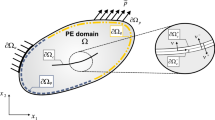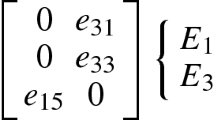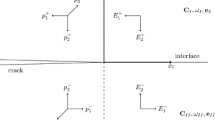Abstract
The failure assessment of smart composite structures requires efficient analytical and numerical techniques in order to tackle electrical and mechanical field concentrations. The present work is directed to the analysis of interface corner and crack configurations which occur in smart composite materials. It delivers a new technique to solve the corresponding piezoelectric boundary value problems. The purpose of the given paper is to describe exactly the asymptotic behaviour at piezoelectric interface corner configurations using the eigenfunction expansions on the one hand, and in the linking of these expansions to regular finite elements on the other. Specific singular eigenfunctions for homogeneous and interface crack configurations are discussed. For the considered cases, the classical crack modes (Mode I and Mode II) and a new Electric Mode are identified. The coupling of the full eigenfunction expansions to the finite elements surrounding the tip region is based on the principle of virtual work applied to the orthogonalised eigenfunctions. Finally, one gets an asymptotic stiffness matrix which does not depend on the distance to the tip. The coefficients of the eigenfunctions can be obtained efficiently from the generalised displacements of the global solution by means of the orthogonalised eigenfunctions. The technique allows to numerically bypass possible singular oscillatory terms in the weak sense, although they actually exist in the strong solution. The given approach is proven and verified in numerical test examples. Standard finite element methods encounter difficulties to give correct solutions at piezoelectric interface crack tips.
Similar content being viewed by others
References
ABAQUS Version 5.8. Hibbitt, Karlsson & Sorensen, Inc. USA 1998.
Abendroth, M., Groh, U., Kuna, M. and Ricoeur, A. (2002). Finite element-computations of the electromechanical J-Integral for 2-D and 3-D crack analysis. International Journal of Fracture 114, 359–378.
Beom, H.G. and Atluri, S.N. (1996). Near-tip fields and intensity factors for interfacial cracks in dissimilar anisotropic piezoelectric media. International Journal of Fracture 75(2), 163–183.
Beom, H.G. and Atluri, S.N. (2002). Conducting cracks in dissimilar piezoelectric media. International Journal of Fracture 118, 285–301.
Chen, M.-C. and Sze, K.Y. (2001). A novel hybrid finite element analysis of bimaterial wedge problems. Engineering Fracture Mechanics 68(13), 1463–1476.
Chen, W.Q. and Shioya, T. (1999). Fundamental solution for a penny-shaped crack in a piezoelectric medium. Journal of the Mechanics and Physics of Solids 47, 1459–1475.
Chen, W.Q. and Shioya, T. (2000). Complete and exact solutions of a penny-shaped crack in a piezoelectric solid: Antisymmetric shear loadings. International Journal of Solids and Structures 37, 2603–2619.
Chen, W.Q., Shioya, T. and Ding, H.J. (2001). An antisymmetric problem of a penny-shaped crack in a piezoelectric medium. Archive of Applied Mechanics 71, 63–73.
Cherepanov, G.P. (1977). Invariant G-integrals and some of their applications in mechanics. Journal of Applied Mathematics and Mechanics (Translation of Prikladnaja Matematika i Mekhanika-PMM) 41(3), 397–410.
Fabrikant, V.I. (1989). Application of potential theory in mechanics: A selection of new results. Kluwer Academic Publishers, The Netherlands.
Fulton, C.C. and Gao, H. (2001). Effect of local polarization switching on piezoelectric fracture. Journal of the Mechanics and Physics of Solids 49(4), 927–952.
Gabbert, U. and Tzou, H.S. (2001). Smart structures and structonic systems, Proceedings of IUTAM-Symposium, Magdeburg, 2000. Kluwer Academic Publishers, Dordrecht.
Gao, C.-F. and Wang, M.-Z., (2000). Collinear permeable cracks between dissimilar piezoelectric materials. International Journal of Solids and Structures 37(36), 4969–4986.
Gao, C.-F. and Wang, M.-Z., (2001). Green's functions of an interfacial crack between two dissimilar piezoelectric media. International Journal of Solids and Structures 38(30-31), 5323–5334.
Govorukha, V.B. and Loboda, V.V. (2000). Contact zone models for an interface crack in a piezoelectric material. Acta Mechanica 140(3-4), 233–246.
Groh, U. (2002). Entwicklung van Randelementen zur elektromechanischen Festigkeitsanalyse van piezoelektrischen Strukturen mit Defekten. Forschungsbericht zum DFG-Vorhaben KU 929/4-1/2, Institut für Mechanik und Fluiddynamik, TU Bergakademie Freiberg.
Gu, B., Yu, S.-W. and Feng, X.-Q. (2002). Transient response of an interface crack between dissimilar piezoelectric layers under mechanical impacts. International Journal of Solids and Structures 39(7), 1743–1756.
Herrmann, K.P., Loboda, V.V. and Govorukha, V.B. (2001). On contact zone models for an electrically impermeable interface crack in a piezoelectric bimaterial. International Journal of Fracture 111(3), 203–227.
Heuberger, A. (Editor) (1991). Mikromechanik, Mikrofertigung mitMethoden der Halbleitertechnologie. Springer-Verlag, Berlin Heidelberg New York.
Huber, J.E. and Fleck, N.A. (2001). Multi-axial electrical switching of a ferroelectric: Theory versus experiment. Journal of the Mechanics and Physics of Solids 49(4), 785–811.
Jung, M. and Langer, U. (2001). Metode der finiten Elemente für Ingenieure. Eine Einführung in die numerischen Grundlagen und Computersimulation. B.G. Teubner, Stuttgart, Leipzig, Wiesbaden.
Kamlah, M., Böhle, U. and Munz, D. (2000). On a non-linear finite element method for piezoelectric structures of hysteretic ferroelectric ceramics. Computational Material Science 19, 81–86.
Karihaloo, B.L. and Xiao, Q.Z. (2001). Accurate determination of the coefficients of elastic crack tip asymptotic field by a hybrid crack element with p-adaptivity. Engineering Fracture Mechanics 68(15), 1609–1630.
Kemmer, G. (2000). Berechnung van elektromechanischen Intensitätsparametrn bei Rissen in Piezokeramiken. Dissertation zur Erlangung des akademischen Grades Doktoringenieur, Technische Universität Dresden, Fakultät für Maschinenwesen.
Kessler, H. and Balke, H. (2001). On the local and average energy release in polarization switching phenomena. Journal of the Mechanics and Physics of Solids 49(5), 953–978.
Kolmogorov, A.I. and Fomin, S.W. (1976). Elements of the Theory of Functions and Functional Analysis (in Russian). Nauka, Moskva.
Korn, G.A. and Korn, T.M. (1968). Mathematical Handbook. McGraw-Hill Book Company, London.
Kumar, S. and Singh, R.N. (1996). Crack propagation in piezoelectric materials under combined mechanical and electrical loadings. Acta Materialia 44(1), 173–200.
Kumar, S. and Singh, R.N. (1997). Energy release rate and crack propagation in piezoelectric materials. Part I: Mechanical/electrical load; Part II: Combined mechanical and electrical loads. Acta Materialia 45(2), 849–868.
Kumar, S., Singh, R.N., Park, S. and Sun, S.T. (1996). Comment on 'Fracture criteria for piezoelectric ceramics' [and reply]. Journal of the American Ceramic Society 79(4), 1133–1136.
Kuna, M. (1998). Finite element analyses of crack problems in piezoelectric structures. Computational Materials Science 13, 67–80.
Kuna, M. and Zwicke, M. (1990). A mixed hybrid finite element for three-dimensional elastic crack analysis. International Journal of Fracture 45(1), 65–79.
Kuo, C.-M. and Barnett, D.M. (1991). Stress singularities of interfacial cracks in bonded piezoelectric half-spaces. In J.J. Wu, T.T.C. Ting and D.M. Barnett, Eds., Modern Theory of Anisotropic Elasticity and Applications, pp. 33-50, Philadelphia 1991. SIAM Proceedings Series.
Lee, J. and Gao, H. (1995). A hybrid finite element analysis of interface cracks. International Journal for Numerical Methods in Engineering 38(14), 2465–2482.
Lekhnitskii, S.G. (1981). Theory of Elasticity of an Anisotropic Body. Mir Publishers, Moscow.
Li, S. and Kam Liu, W. (2000). Numerical simulations of strain localization in inelastic solids using mesh-free methods. International Journal for Numerical Methods in Engineering 48, 1285–1309.
McMeeking, R.M. (2001). Towards a fracture mechanica for brittle piezoelectric and dielectric materials. International Journal of Fracture 108(1), 25–41.
Meguid, S.A. and Zhao, X. (2002). The interface crack problem of bonded piezoelectric and elastic half-space under transient electromechanical loads. Transactions of the ASME. Journal of Applied Mechanics 69(3), 244–253.
Mußchelichwili, N.I. (1971). Einige Grundaufgaben zur mathematischen Elastizitätstheorie. VEB Fachbuchverlag, Leipzig.
Needleman, A. (1988). Material rate dependence and mesh sensitivity in localization problems. Computer Methods in Applied Mechanics and Engineering 67(1), 69–85.
Nishioka, T. and Shen, S. (2001). Higher order asymptotic solution for an interfacial crack in piezoelectric bimaterial under impact. Materials Science Research International 7(3), 157–165.
Pak, Y.E. (1992). Linear electro-elastic fracture mechanica of piezoelectric materials. International Journal of Fracture 54(5), 79–100.
Park, S. and Sun, C.T. (1995a). Effect of electric field on fracture of piezoelectric ceramics. International Journal of Fracture 70, 203–216.
Park, S. and Sun, C.T. (1995b). Fracture criteria for piezoelectric ceramics. Journal of the American Ceramic Society 78(6), 1475–1480.
Parton, V.Z. and Kudrjavcev, B.A. (1988). Electromagnetoelasticity, piezoelectrics and electrically conductive solids. Gordon and Breach, New York.
Pian, T.H.H. and Moriya, K. (1978). Three-dimensional fracture analysis by assymed stress hybrid elements. In A.R. Luxmoore, Editor, Proceedings of the International Conference on Numerical Methods in Fracture Mechanics, Swansea 9-13 January 1978, pp. 263–373, Pineridge Press, Swansea.
Qin, Q.-H. (2001). Fracture Mechanics of Piezoelectric Materials. WIT Press, Southampton, Boston.
Qin, Q.-H. and Mai, Y.-W. (1999). Closed crack tip model for interface cracks in thermopiezoelectric materials. International Journal of Solids and Structures 36(16), 2463–2479.
Qin, Q.-H. and Mai, Y.-W. (2000). Crack branch in piezoelectric bimaterial system. International Journal of Engineering Science 38(6), 673–693.
Ru, C. (2000). Electrode-ceramic interfacial cracks in piezoelectric multilayer materials. Journal of Applied Mechanics, Transactions ASME 67(2), 255–261.
Savin, G.N. (1968). Distribution of Stresses at Holes (in Russian). Naukova Dumka, Kiew.
Scherzer, M. (1994). Asymptotic equations for bimaterial interface corners in the non-linear deformation field. In: K.H. Schwalbe and M. Kocak, Editors, Mis-Matching of Welds, pp. 161–175, Mechanical Engineering Publication, London.
Scherzer, M. (1997a). Non-linear deformed interface corner stress characterization by effective parallel numerical methods. In B.L. Karihaloo, Y.W. Mai, M.I. Ripley and R.O. Ritchie, Eds., Advances in Fracture Research, Proceedings of the 9th International Conference on Fracture 1-5 April 1997, Sydney, Australia, vol. 4, pp. 1959–1970, Amsterdam-Oxford-New York-Tokyo-Lausanne. Pergamon Press.
Scherzer, M. (1997b). Stress fields at interface-corners and cracks for non-linear deformations. In H.-P. Rossmanith, Editor, Damage and Failure of Interfaces, Proceedings of the First International Conference-DFI-1/Vienna/Austria/22-24 September 1997, pp. 67–74, Rotterdam/Brookfield. A.A. Balkema.
Scherzer, M. (1999). Physikalisch und geometrisch nichtlineare Problemstellungen der Festkörper-und Bruchmechanik an Interface-Konfigurationen. Habilitationsschrift, Technische Universität Bergakademie Freiberg.
Scherzer, M. (2001). Elektromechanische Modellierung und Bewertung der Festigkeit von Verbundwerkstoffen mit integrierten Piezokeramiken. Wissenschaftlicher Bericht im Rahmen der Förderung innovativer Forschung, Projektnummer: 4-7566-70-0390-98/4, SMWK Dresden.
Scherzer, M. and Kuna, M. (2000). Numerical analyses of cracks in piezoelectric composite structures under electromechanical loading. In M. Fuentes, M. Elices, A. Martin-Meizoso and J.M. Martinez-Esnaola, Eds., Proceedings of the 13th European Conference on Fracture, 6th––9th September 2000, San Sebastian, Spain, pp.
Scherzer,M. and Kuna,M. (2000). Asymptotic analysis of interface problems in piezoelectric composite materials. In K.-H. Hoffmann, Editor, Smart Materials, pp. 137-148, Berlin 2001. Springer Verlag, Proceedings of the first caesarium, Bonn, November 17-19, 1999. CD1-CD8 (Ceramics). Elsevier Science.
Scherzer, M. and Meyer, A. (1996). Zur Berechnung von Spannungs-und Deformationsfeldern an Interface-Ecken im nichtlinearen Deformationsbereich auf Parallelrechnern. Preprint-Reihe des Chemnitzer Sonderforschungsbereiches 393 (Numerische Simulation auf massiv parallelen Rechnern), Nr.: 96-03, TU Chemnitz-Zwickau, Fakultät für Mathematik.
Shang, F., Kuna, M. and Abendroth, M. (2003). Finite element analyses of three-dimensional crack problems in piezoelectric structures. Engineering Fracture Mechanics 70, 143–160.
Shang, F., Kuna, M. and Scherzer, M. (2002). Analytical solutions for two penny-shaped crack problems in thermopiezoelectric materials and their finite element comparisons. International Journal of Fracture 117, 113–128.
Shen, S., Nishioka, T., Kuang, Z.-B. and Liu, Z. (2000). Nonlinear electromechanical interfacial fracture for piezoelectric materials. Mechanics of Materials 32(1), 57–64.
Sih, G.C. and Liebowitz, H. (1968). Mathematical theories of brittle fracture, pp. 67–190 Chapter 2 in: Fracture, edited by H. Liebowitz, Academic Press, New York.
SPIE. (2000, 2001, 2002). Proceedings of Conferences on 'Smart Structures and Materials'. Proceedings of SPIE-The International Society for Optical Engineering Bellingham, USA.
Sosa, H. (1991). Plane problems in piezoelectric media with defects. International Journal of Solids and Structures 28(4), 491–505.
Stroh, A.N. (1958). Dislocations and cracks in anisotropic elasticity. Philosophical Magazine 7, 625–646.
Sunar, S. and Rao, S.S. (1999). Recent advances in sensing and control of flexible structures via piezoelectric materials technology. Applied Mechanics Reviews 52(1), 1–16.
Suo, Z., Kuo, C.-M., Barnett, D.M. and Willis, J.R. (1992). Fracture mechanics for piezoelectric ceramics. International Journal of Solids and Structures 40(4), 739–765.
Sze, K.Y. and Pan, Y.-S. (2001). Nonlinear fracture analysis of piezoelectric ceramics by finite element method. Engineering Fracture Mechanics 68(11), 1335–1351.
Tamuzs, V., Romanlis, N. and Petrova, V. (2000). Fracture of Solids with Microdefects. Nova Science Publishers, Inc., Huntington, New York.
Tian, W.-Y. and Chen, Y.-H. (2000). Interaction between an interface crack and subinterface microcracks in metal/piezoelectric bimaterials. International Journal of Solids and Structures 37(52), 7743–7757.
Tong, P. (1977). A hybrid crack element for rectilinear anisotropic material. International Journal for Numerical Methods in Engineering 11, 377–282.
Tong, P., Pian, T.H.H. and Lasry, S.J. (1973). A hybrid-element approach to crack problems in plane elasticity. International Journal for Numerical Methods in Engineering 7, 297–308.
Wang, T.C. and Han, X.L. (1999). Fracture mechanics of piezoelectric materials. International Journal of Fracture 98(1), 15–35.
Wang, X. and Shen, Y.-P. (2002). Exact solution for mixed boundary value problems at anisotropic piezoelectric bimaterial interface and unification of various interface defects. International Journal of Solids and Structures 39(6), 1591–1619.
Wu, C.C., Sze, K.Y. and Huang, Y.Q. (2001). Numerical solutions on fracture of piezoelectric materials by hybrid element. International Journal of Solids and Structures 38(24-25), 4315–4329.
Xu, X.-L. and Rajapakse, R.K.N.D. (2000). On singularities in composite piezoelectric wedges and junctions. International Journal of Solids and Structures 37(23), 3253–3275.
Yang, J.H. and Lee, K.Y. (2001). Penny shaped crack in a three-dimensional piezoelectric strip under in-plane normal loadings. Acta Mechanica 148, 187–197.
Zhang, T.-Y., Zhao, M. and Tong P. (2002). Fracture of piezoelectric ceramics. Advances in Applied Mechanics 38, 147–289.
Author information
Authors and Affiliations
Rights and permissions
About this article
Cite this article
Scherzer, M., Kuna, M. Combined analytical and numerical solution of 2D interface corner configurations between dissimilar piezoelectric materials. International Journal of Fracture 127, 61–99 (2004). https://doi.org/10.1023/B:FRAC.0000035056.34258.4b
Issue Date:
DOI: https://doi.org/10.1023/B:FRAC.0000035056.34258.4b




